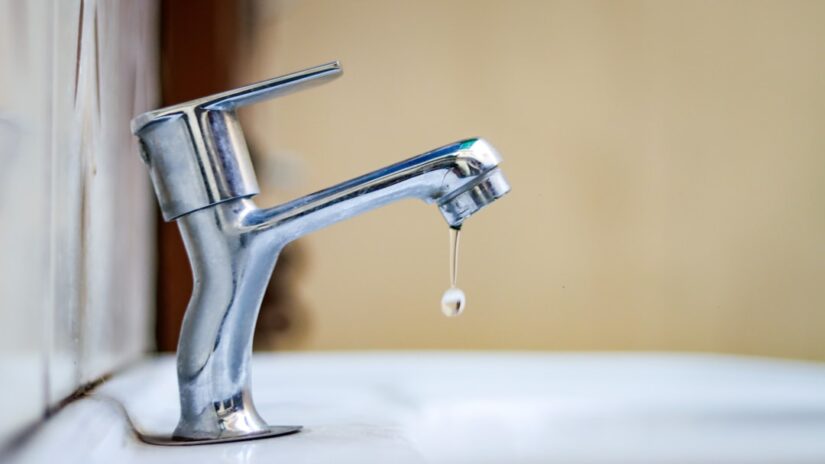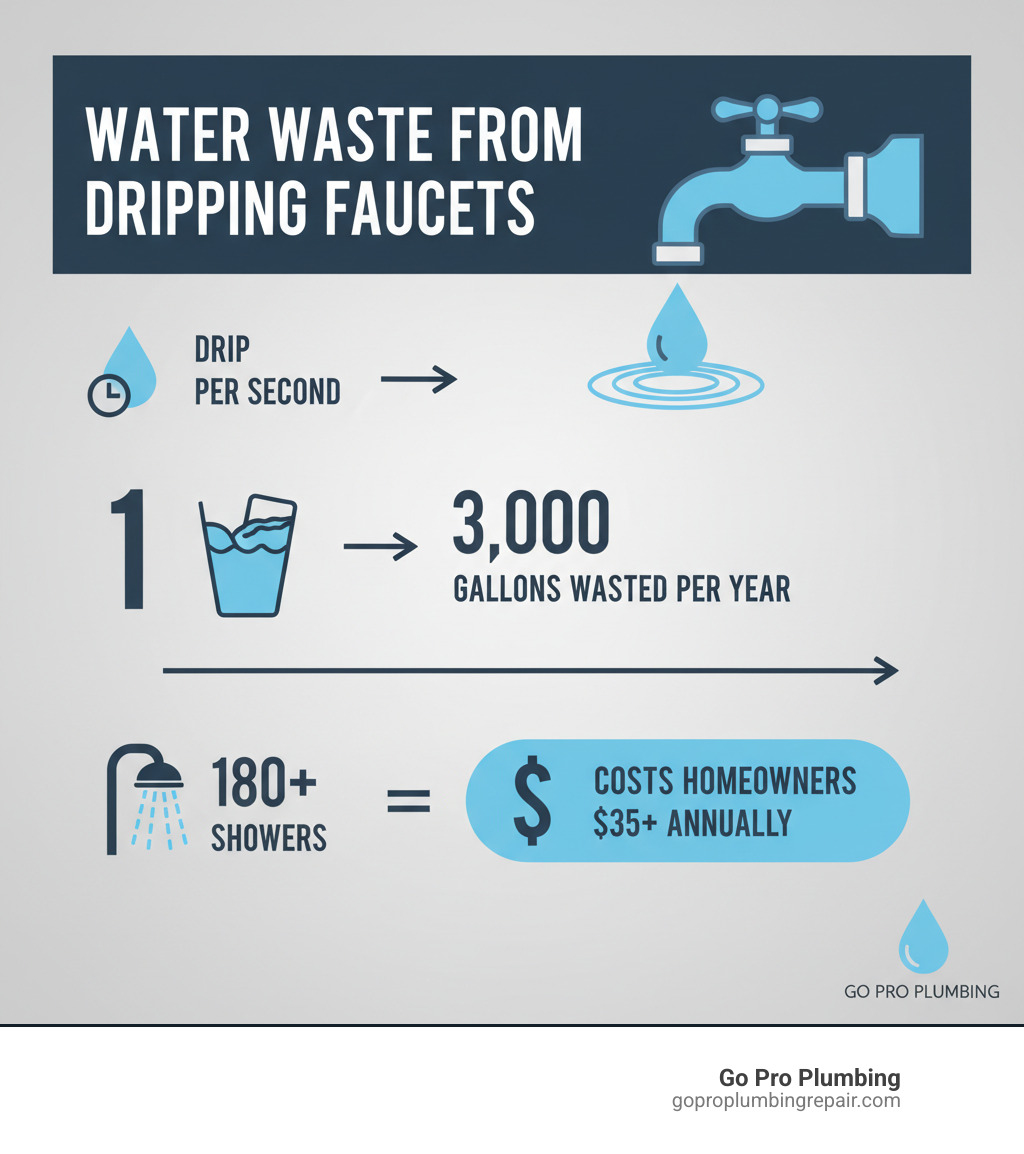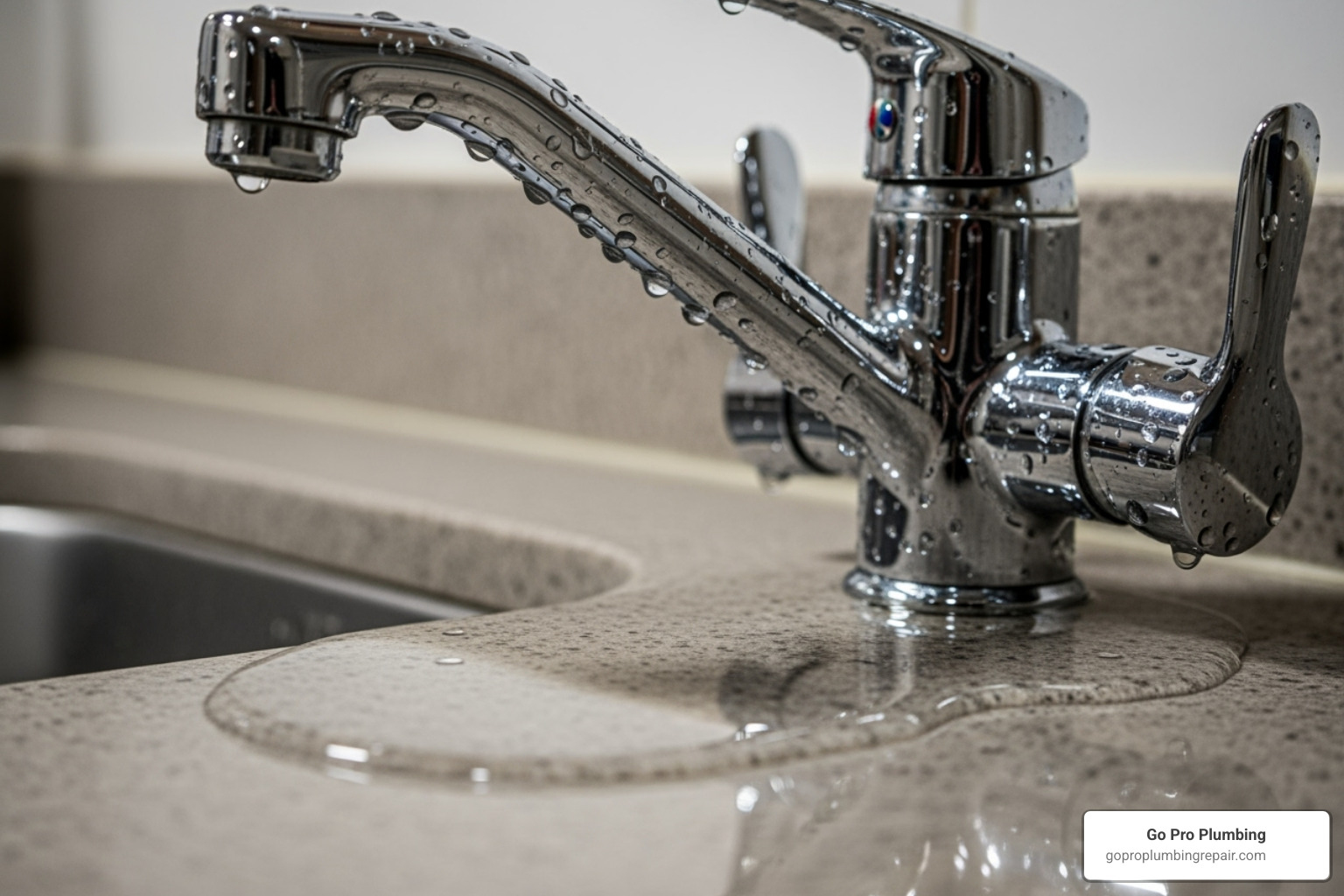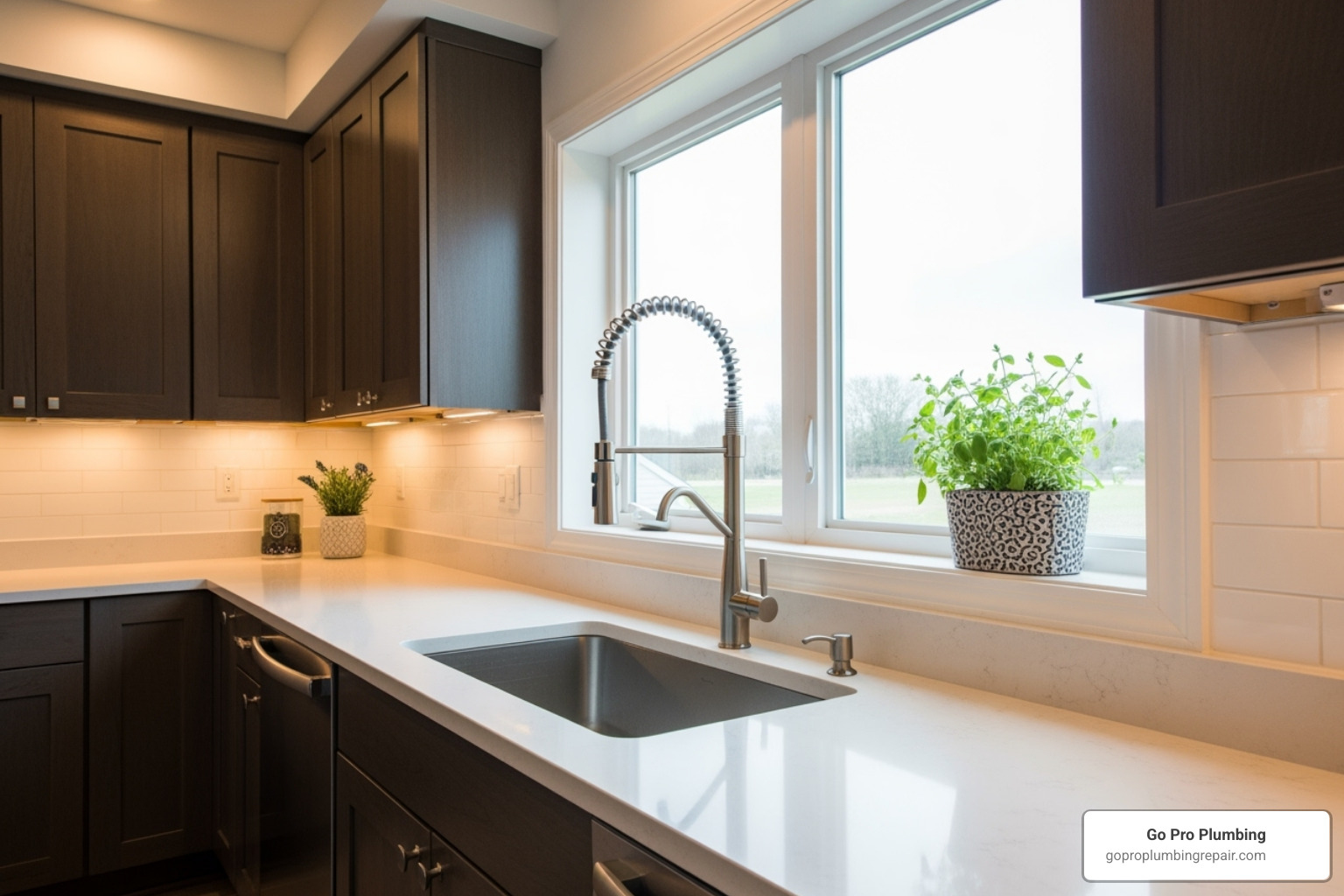The Easiest Way to Repair Faucet & Sink Issues
By Brian on November 3, 2025

Why Faucet and Sink Repair Matters for Your Home
Faucet and sink repair is one of the most common plumbing issues homeowners face, and ignoring these problems can cost you hundreds of dollars in wasted water and potential damage. A single dripping faucet can waste up to 3,000 gallons of water per year – that’s enough to take more than 180 showers!
Quick Solutions for Common Issues:
- Dripping faucet – Usually caused by worn washers, O-rings, or cartridges
- Slow drainage – Often fixed by cleaning the P-trap or removing hair clogs
- Low water pressure – Check and clean the aerator first
- Water pooling at base – Replace worn O-ring or tighten connections
- Complete blockage – May require professional drain cleaning
The good news? Many faucet and sink problems are surprisingly easy to fix yourself with basic tools and a little know-how. Simple repairs like replacing a washer or cleaning an aerator can be completed in under an hour and cost less than $10 in parts.
But knowing when to tackle a repair yourself versus calling a professional can save you from turning a small problem into an expensive disaster. Water damage from a botched repair can cost thousands – far more than the original issue.
Whether you’re dealing with a constant drip that’s driving up your water bill or a sink that won’t drain properly, understanding your options helps you make the right choice for your situation and budget.

Your Complete Guide to Faucet and Sink Repair
At Go Pro Plumbing, we’ve seen it all when it comes to faucet and sink repair issues. From the classic midnight drip that keeps you awake to the mysterious puddle that appears under your kitchen sink every morning, these problems have a way of demanding attention at the most inconvenient times.
The good news? Most faucet and sink issues follow predictable patterns, and many can be fixed with some basic knowledge and the right approach. Whether you’re a confident DIYer or someone who’d rather call in the professionals, understanding what’s happening with your plumbing helps you make smart decisions about repairs.
Common Reasons for Faucet and Sink Repair
That annoying drip, drip, drip echoing through your kitchen at 2 AM isn’t just robbing you of sleep – it’s literally money going down the drain. A single dripping faucet wastes up to 3,000 gallons of water annually, which explains why your water bill keeps creeping higher.

Dripping faucets are the most common complaint we hear about, and they’re usually caused by worn internal parts that have given up the ghost. The main troublemakers are worn-out washers in older compression faucets – these little rubber seals work hard every time you turn the water on and off, eventually becoming cracked or warped.
Faulty O-rings create their own special brand of chaos, typically causing water to pool around the base of your faucet or leak from where the spout connects. These small rubber rings seal the moving parts, but they don’t last forever, especially in homes with hard water.
Modern faucets often use cartridges to control water flow and temperature. When these wear out from mineral deposits or just plain old age, you might find yourself wrestling with a faucet that won’t stop dripping or refuses to give you the right water temperature.
Low water pressure can turn your morning routine into a frustrating ordeal. Often, this starts with a clogged aerator – that little screen at the tip of your faucet that gets gunked up with mineral deposits. Sometimes the problem runs deeper into your supply lines, but the aerator is always worth checking first.
Visible corrosion shows up as those crusty white or green deposits that make your once-shiny faucet look like it belongs in a haunted house. This mineral buildup doesn’t just look bad – it actually eats away at your faucet’s components over time.
Sink problems bring their own headaches. Slow drains turn simple tasks like washing dishes into waiting games, while complete blockages can shut down your kitchen or bathroom entirely. Hair, grease, soap scum, and mystery objects all conspire to create these clogs.
If you’re dealing with unpleasant odors wafting up from your drain, our guide on Smelly Sink Drain can help you tackle that particular problem. Cracks in the sink basin are less common but more serious, potentially leading to leaks that can damage your cabinets and flooring.
DIY Faucet and Sink Repair: A Step-by-Step Guide
Rolling up your sleeves for faucet and sink repair can be incredibly satisfying – there’s something deeply rewarding about fixing a problem with your own hands. Plus, you’ll save money and gain valuable knowledge about your home’s plumbing system.
Essential tools make all the difference between a smooth repair and a frustrating ordeal. You’ll want an adjustable wrench for most jobs, along with both Phillips and flathead screwdrivers. Pliers help grip small parts, while plumber’s tape ensures watertight connections. Don’t forget a bucket and rags – trust us, you’ll need them.
Shutting off the water supply is absolutely critical and non-negotiable. Look under your sink for individual shut-off valves – turn them clockwise until snug. If you can’t find these valves or they’re stuck, you’ll need to shut off your home’s main water supply. Always test that the water is truly off by turning on the faucet before you start working.
Fixing a faucet leak starts with identifying what type of faucet you have. Compression faucets are the old-school type with separate hot and cold handles, while cartridge, ball, and ceramic disc faucets are more modern designs. Each requires a slightly different approach, but the basic process involves removing the handle, accessing the internal components, and replacing worn parts. Our detailed guide on How to fix a faucet leak walks you through each type.
Replacing a faucet cartridge might sound intimidating, but it’s often just a matter of removing a retaining clip or nut, pulling out the old cartridge, and sliding in the new one. The key is taking the old cartridge to the hardware store to ensure you get an exact match.
When it comes to unblocking a sink, start simple before moving to more complex solutions. A good plunger can clear many clogs, especially when combined with enough water to create a proper seal. For detailed techniques, check out our comprehensive guide on Unblocking a Sink.
Cleaning the P-trap – that curved pipe under your sink – often solves persistent drainage issues. Place a bucket underneath, loosen the slip nuts with a wrench, and prepare to be amazed (and possibly disgusted) by what you find inside. This trap catches debris to prevent clogs deeper in your plumbing system.
Fixing a pop-up drain in bathroom sinks usually involves removing hair and grime from the stopper mechanism. Sometimes the problem is as simple as adjusting the pivot rod that controls the stopper’s movement.
Hair removal deserves special mention because it’s such a common culprit in bathroom sink clogs. Our guide on Sink Hair Removal offers specific strategies for dealing with this particular nemesis.
There’s no shame in calling a professional when a repair feels beyond your comfort zone. We’re always here to help Northern California homeowners when DIY turns into “Don’t, I Yield!”
Beyond Repair: When to Replace Your Faucet or Sink
Sometimes, even the most determined DIYer has to face reality: that trusty old faucet has given its last drop, and no amount of faucet and sink repair wizardry will bring it back to life. Knowing when to wave the white flag and invest in a replacement can actually save you money, frustration, and countless trips to the hardware store.
Deciding Between Repair and Replacement
The million-dollar question isn’t really about money at all – it’s about making the smart choice for your home and your sanity. Let’s break down the key factors that should guide your decision:
Age is more than just a number when it comes to plumbing fixtures. Most faucets have a lifespan of 5-10 years, depending on their quality and how much use they get. If your kitchen faucet has been faithfully serving your family’s dishwashing marathons for over a decade, it might be time to give it a well-deserved retirement.
The cost comparison often tells the whole story. When replacement parts for your vintage faucet cost nearly as much as a brand-new fixture, the math becomes pretty clear. Why spend $40 on a cartridge for a 12-year-old faucet when you could invest $60 in a shiny new one with modern features?
Frequency of repairs is another telltale sign. If you’re becoming best friends with your local plumbing supply store clerk because you’re there every few months buying washers, O-rings, or other parts for the same stubborn faucet, it’s trying to tell you something. Listen to it.
Parts availability can make the decision for you. Manufacturers discontinue older models, and finding compatible parts for that unique faucet you loved 15 years ago might be impossible. When you can’t find the parts, replacement becomes your only option.
Water damage risk is the serious consideration that trumps all others. If your faucet is leaking intermittently or you’re dealing with hidden leaks that could damage cabinets, flooring, or even structural elements, don’t gamble with repairs. The cost of water damage repair far exceeds the price of a new faucet.
| Feature | Repair | Replacement |
|---|---|---|
| Cost | Lower initial cost (parts often under $20-$50) | Higher initial cost (new fixture $50-$500+, installation) |
| Effort | Can be DIY, few hours of work | Can be DIY, but more involved; professional installation recommended |
| Longevity | Extends life of existing fixture, but original issue may recur | New fixture offers full lifespan (typically 5-10 years) |
| Benefits | Quick fix, avoids major project | Modern aesthetics, improved functionality, water efficiency, increased home value |
| Considerations | Parts availability, age of fixture, frequency of issues, underlying damage | Matches decor, budget, desired features, plumbing compatibility |
Benefits of Upgrading Your Fixtures

Upgrading your faucets and sinks isn’t just about fixing a problem – it’s about changing your daily experience with water in your home. The benefits go far beyond simply stopping that annoying drip.
Water conservation has become a major selling point for modern fixtures. Today’s faucets are designed with efficiency in mind, using significantly less water than older models while maintaining excellent pressure and performance. WaterSense-labeled products can reduce your household water consumption by up to 30%, which translates directly to lower utility bills.
Energy efficiency matters more than you might think. When your faucet uses less hot water, your water heater doesn’t have to work as hard, reducing your energy costs. New regulations have introduced energy efficiency standards for faucets, making them genuine energy-saving appliances.
Your home’s value gets an instant boost with updated fixtures. Real estate professionals consistently report that kitchens and bathrooms sell homes, and outdated, corroded, or constantly dripping faucets send the wrong message to potential buyers. A sleek, modern faucet suggests that the home has been well-maintained.
Modern features can genuinely improve your daily life. Touchless faucets aren’t just fancy – they’re incredibly practical when your hands are covered in raw chicken or paint. Pull-out sprayers in kitchen sinks make washing large pots and cleaning the sink itself so much easier. Precise temperature control means no more scalding surprises or lukewarm disappointments.
Improved aesthetics can completely transform a room’s appearance. That harvest gold faucet from 1987 isn’t coming back into style anytime soon, but a clean, contemporary fixture can make your entire kitchen or bathroom feel updated and fresh.
Choosing the Right New Faucet or Sink
When replacement time arrives, the sheer number of options can feel overwhelming. Here’s how to steer the choices without getting lost in the plumbing aisle.
Sink materials each have their own personality. Stainless steel is the workhorse of kitchen sinks – durable, heat-resistant, and practically indestructible. It shows water spots but cleans up easily. Porcelain offers that classic, timeless look and comes in colors beyond white, though it can chip if you drop something heavy. Composite sinks blend materials like granite and resin to create surfaces that resist scratches, chips, and heat while offering unique colors and textures.
Faucet types depend on your sink’s configuration. Centerset faucets work with the standard three holes spaced 4 inches apart that you’ll find in most older sinks. The spout and handles are connected on one base unit, making installation straightforward. Widespread faucets also use three holes but spread them 6 to 16 inches apart, with separate components that create a more neat, customized appearance. Single-hole faucets need just one opening and often include deck plates to cover extra holes if your sink has them.
Faucet finishes contribute significantly to your room’s style. Chrome remains popular because it’s affordable and matches everything, though it shows water spots. Brushed nickel hides fingerprints and water marks better. Bronze finishes add warmth and work beautifully in traditional settings. Matte black has become trendy for its bold, contemporary look.
For comprehensive guidance on kitchen options, our Complete Kitchen Sink Faucet Guide covers everything from measuring to installation. When you’re ready to tackle the project, having the right information makes all the difference between a successful upgrade and a weekend-ruining disaster.
The key to choosing well is balancing your budget, your home’s style, and the features that will actually improve your daily routine. That touchless faucet might seem like overkill until you’re juggling a crying baby and need to wash bottles one-handed.
The Professional Touch: Benefits of Hiring a Plumber
While many faucet and sink repair tasks are perfectly suited for the weekend DIY warrior, there are definitely times when calling a professional plumber isn’t just smart – it’s absolutely necessary. At Go Pro Plumbing, we’ve seen plenty of well-intentioned repairs that turned into much bigger (and more expensive) problems than they started as.

Let’s be honest – some plumbing jobs look deceptively simple until you’re knee-deep in the project with water everywhere and parts that don’t quite fit the way they should. Complex installations are prime examples of when professional help becomes invaluable. Installing a wall-mounted faucet might seem straightforward, but it often requires rerouting pipes behind the wall, precise measurements, and sometimes even structural modifications.
Changing a Faucet on a Pedestal Sink is another job that tricks many homeowners – the cramped space and delicate porcelain make it much trickier than a standard sink replacement. Our team handles these specialized installations regularly, so what might take you an entire weekend (plus a few trips to the hardware store) becomes a smooth, efficient process.
When you’re dealing with major leaks or hidden pipe problems, time is absolutely critical. A burst pipe or significant leak can cause thousands of dollars in water damage within hours. If you see water pooling where it shouldn’t be, or if your water bill suddenly spikes without explanation, these are red flags that point to issues beyond a simple washer replacement.
Sometimes the problem isn’t just what you can see – it’s what’s happening behind the walls or under the foundation. Corroded pipes, high water pressure issues, or problems with your water heater can all manifest as faucet problems. A professional can quickly diagnose whether your dripping kitchen faucet is really just a worn O-ring or a symptom of something much more serious.
There’s also the practical side to consider. Professional plumbers come equipped with specialized tools that most homeowners don’t have sitting in their garage. Basin wrenches for tight spaces, pipe threading equipment, and professional-grade drain snakes can make the difference between a quick fix and an all-day struggle.
Code compliance is another crucial factor that many DIYers overlook. Local plumbing codes exist for good reasons – they ensure safety and proper function. When you hire Go Pro Plumbing, you can rest assured that all work meets current Northern California plumbing standards. This protects you from potential fines and ensures your home insurance remains valid.
Perhaps most importantly, our work comes with a warranty and the peace of mind that comes with professional service. If something goes wrong with a repair we’ve completed, we’ll be back to make it right. That’s the kind of assurance you simply can’t get from a DIY project, no matter how confident you feel going into it.
Our experienced team serves Northern California, including Rancho Cordova and Sacramento, with the same commitment to outstanding customer service and same-day service that has built our reputation. We treat every home like it’s our own, and we’re always ready to tackle any faucet and sink repair challenge – whether it’s a simple washer replacement or a complete bathroom renovation.
Frequently Asked Questions about Faucet & Sink Issues
Over our years serving Northern California homeowners, we’ve heard just about every faucet and sink repair question you can imagine. During our service calls in Sacramento and Rancho Cordova, certain questions come up again and again. Let’s tackle the most common ones that might be on your mind too.
How long should a faucet last?
This is probably the most frequent question we get when homeowners are debating whether to repair or replace their fixtures. The honest answer? Most faucets should last between 5-10 years with normal use, but we’ve seen some that keep going strong for 15 years or more.
The quality of your faucet makes a huge difference in longevity. Those solid brass fixtures with ceramic disc valves? They’re built to last. The budget models with plastic internals from the big box store? Not so much. You really do get what you pay for in the plumbing world.
Usage frequency is another big factor. That kitchen faucet that gets turned on and off dozens of times a day will naturally wear out faster than the guest bathroom fixture that sees occasional use. It’s just simple math – more cycles mean more wear on internal components.
Here’s something many homeowners don’t consider: water hardness can dramatically impact faucet lifespan. If you live in an area with hard water (and many parts of Northern California definitely qualify), those mineral deposits build up inside your faucet like concrete. The calcium and magnesium slowly corrode washers, clog aerators, and make moving parts stick. Regular cleaning and occasional part replacement can help, but eventually, hard water wins the battle.
What causes a faucet to drip?
That annoying drip, drip, drip that keeps you awake at night usually comes down to one of four culprits. Understanding which one you’re dealing with can help you decide if it’s a quick DIY fix or time to call us.
Worn-out washers are the classic cause, especially in older compression-style faucets. These little rubber discs create the seal that stops water flow when you turn off the tap. Over time, they harden, crack, or get knocked out of position. The good news? Replacing a washer is usually a $2 fix that takes about 20 minutes.
Faulty O-rings are another common troublemaker. These small rubber rings seal around moving parts like the spout connection. When they get loose, worn, or corroded, water finds its way past them. You’ll often see this as water pooling around the base of your faucet.
Sometimes the problem is a corroded valve seat – that’s where the faucet connects to your water supply line. Hard water minerals love to build up here, creating a rough surface that prevents proper sealing. This one’s a bit trickier to fix and might need professional attention.
In newer faucets, a worn cartridge is often the villain. These control water flow and temperature in modern fixtures. When they wear out from mineral deposits or just plain old age, you get drips, temperature control problems, or both.
Can I replace just the faucet handle?
Absolutely! This is actually one of our favorite faucet and sink repair questions because the answer is usually “yes, and it’s easier than you think.”
Maybe your handle cracked, got stripped out, or you just want to update the look without replacing the whole faucet. Ensuring compatibility is the key here – handles aren’t one-size-fits-all. You’ll need to match your faucet’s brand, model, and style. A Delta handle won’t fit a Moen faucet, and a single-handle replacement won’t work on a two-handle setup.
Replacement handles are often sold in repair kits that include other small parts you might need. Sometimes these kits are actually cheaper than buying just the handle alone, plus you’ll have spare O-rings and screws for future repairs.
The actual replacement process is usually straightforward – most handles are held on by a single screw that might be hidden under a decorative cap. Pop off the cap, remove the screw, pull off the old handle, and reverse the process with the new one.
If you’re replacing just one handle on a two-handle faucet, make sure the new one matches the existing style and finish. Nothing says “DIY gone wrong” like mismatched handles! When in doubt, take a photo of your current setup to the hardware store – it’ll save you a return trip.
Conclusion
Whether you’ve been dealing with that annoying drip, drip, drip that keeps you awake at night or facing a completely blocked sink that’s brought your morning routine to a standstill, faucet and sink repair issues are simply part of owning a home. The good news? You now have the knowledge and confidence to tackle many of these problems head-on.
Throughout this guide, we’ve walked you through everything from identifying worn washers and O-rings to knowing when it’s time to upgrade to a beautiful new fixture. The most important thing to remember is that early action saves money. That single drip might seem harmless, but it’s literally money going down the drain – up to 3,000 gallons per year!
Regular maintenance is your best friend when it comes to avoiding major plumbing disasters. A quick check of your faucet’s aerator, an occasional cleaning of the P-trap, or simply being aware of how your fixtures are performing can prevent small issues from becoming expensive emergencies.
We’ve also shown you that understanding your faucet’s internal components – whether it’s a simple compression faucet or a modern ceramic disc model – makes repairs much less intimidating. Sometimes all you need is a $2 washer and 30 minutes of your time to solve a problem that’s been driving you crazy for months.
But here’s the thing: there’s absolutely no shame in calling the professionals. Some jobs require specialized tools, expertise, or simply more time than you have available. Complex installations, hidden pipe problems, or situations where you’re just not comfortable with the repair – that’s exactly when our Go Pro Plumbing team shines.
We’re proud to serve homeowners and businesses throughout Northern California, including Rancho Cordova and Sacramento, with the same commitment to outstanding customer service that sets us apart. Our licensed and experienced technicians treat every job – whether it’s a simple washer replacement or a complete kitchen renovation – with the care and attention your home deserves.
Don’t let a minor faucet and sink repair issue turn into a major headache or expensive water damage. Whether you decide to tackle it yourself or want the peace of mind that comes with professional service, the important thing is taking action sooner rather than later.
Ready to get that plumbing problem solved once and for all? For professional faucet and sink services in Northern California, contact us today!
